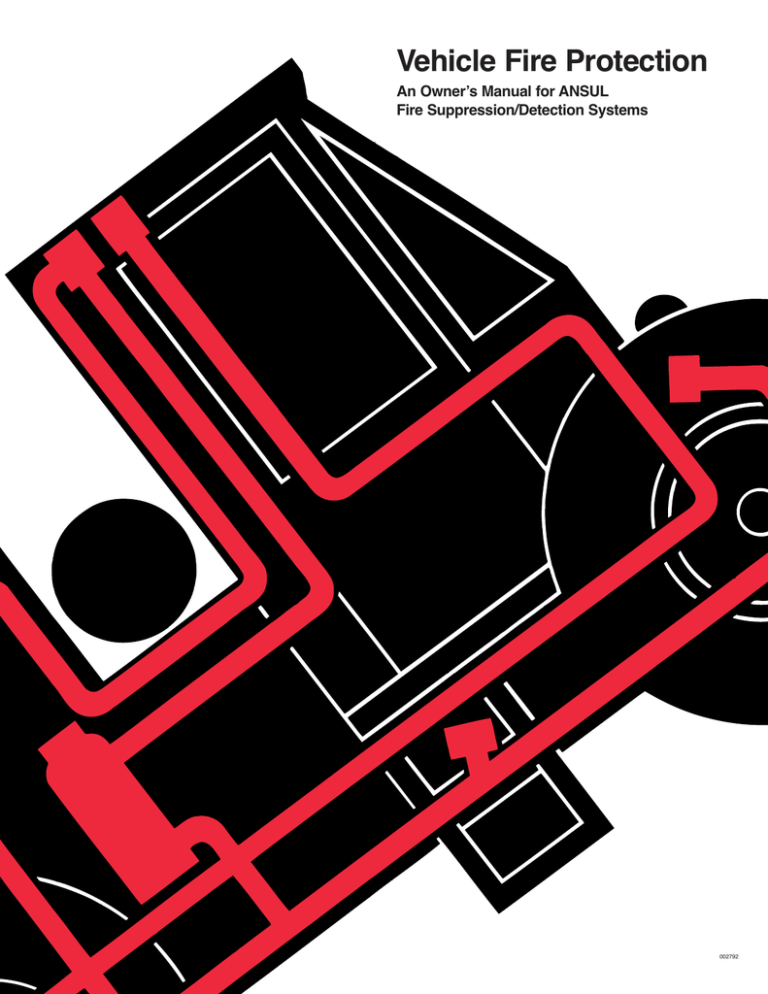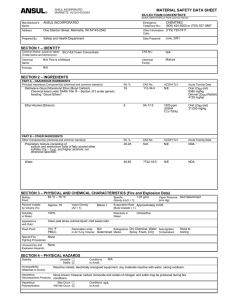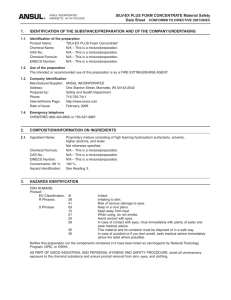
Vehicle Fire Protection
An Ownerʼs Manual for ANSUL
Fire Suppression/Detection Systems
002792
Off-road vehicles do have fires
Statistics show that off-road vehicles burn…with
alarming frequency. These vehicles are susceptible to
fire for several reasons. They often operate steady for
several hours at a time (sometimes around the clock).
They use flammable liquids – lubricating oil, gasoline,
diesel oil, greases and hydraulic fluids – in their
normal operation. They also generate heat – from
engine blocks, manifolds, turbochargers and brake
systems – which can ignite these flammable liquids
and debris.
Since the passage of the federal and state clean air
acts, many vehicles, including most busses operated
by mass transit authorities and state agencies, have
been converting to cleaner burning fuels such as
LPG, LNG, and CNG instead of gasoline or diesel
fuel. Use of these fuels is an essential component of
improving our environment, but their use raises the
possibility of dangerous gas leaks.
Insurance companies are well aware of these facts.
That's why insurance rates are skyrocketing.
As the owner of a vehicle equipped with an ANSUL
Fire Detection/Suppression System, you've taken an
important step in facing the fire problem. You are
dramatically reducing your potential fire loss and
helping to ensure personnel safety.
This owner's guide has been provided to help
you understand how your ANSUL Fire
Detection/Suppression System works, your
responsibilities for fire prevention and maintenance, and what to do in case of fire. In no way is
this guide intended to provide detailed installation
instructions. Should you have any questions or
require assistance, contact your nearest authorized ANSUL products distributor or ANSUL
Technical Services.
When fire breaks out, it can result in expensive repair
or replacement of valuable equipment, costly downtime or loss of business continuity. Worse yet, it can
mean serious personal injury to vehicle operators or
passengers.
Turbocharger
Exhaust
Manifold
Transmission &
Disc Brake
Battery Box
Hydraulic
Pump Hose
Area
Engine
Block
Typical Vehicle
Fire Hazard Areas
002776
SAFETY
PRECAUTIONS
The fire system described in these materials is a
suppression system only and is not designed or
intended to extinguish all fires, particularly when
unusual amounts of combustible materials and an
ample oxygen supply are present. It is extremely
important that alternative firefighting equipment be
available in case the system does not totally extinguish a fire.
Use extreme care to prevent the accumulation of
debris, combustible materials and fluids which could
intensify the fire or cause it to spread to areas where
there was no previous potential for fire.
If modifications are made to the equipment being
protected or if the fire detection and/or suppression
system is disconnected for any reason, make certain
the fire equipment is immediately inspected and
tested by an authorized ANSUL vehicle systems
distributor.
If an automatic fire detection and actuation system
has not been supplied or has been disconnected,
system actuation and discharge will not occur unless
the fire suppression system is manually actuated.
Reliance on a manual release system usually results
in a slower reaction to fire.
Your role in
protecting your
vehicle from fire
Your ANSUL Fire Suppression System is customdesigned to protect specific hazard areas on your
vehicle. It’s been carefully engineered for reliability
and built to the highest quality standards. Every
component has been tested to ensure long life and
dependable performance.
With proper maintenance, your ANSUL Fire
Suppression System should give you years of fire
protection.
The main purpose of the manual, however, is to
explain the most basic form of fire protection – fire
prevention. It outlines steps you can take to prevent a
disastrous fire. Precautions which can greatly reduce
the risk of serious fire damage.
Fire prevention on vehicles relies upon two basic
factors:
1.
2.
Inspection and preventative maintenance at
points where fires are most likely to start –
engine blocks, electrical systems, turbochargers, exhaust manifolds and brake
systems.
Regular cleaning of all areas where flammable
materials such as fuel, oil, grease, hydraulic
fluid and combustible debris may collect.
Vehicle Fire Prevention Maintenance
The following is a suggested daily maintenance outline which can help reduce the risk of fire on your vehicle.
CAUTION: Take care during vehicle maintenance, cleaning, or welding. To avoid unintentionally setting off the system
and the discharge of agent, do not cut, pinch, or apply heat exceeding 200 °F (93 °C) to the detection lines of
the system.
1.
2.
3.
4.
5.
6.
7.
Check all oil, hydraulic fluid and gas lines for cuts,
abrasions or undue wear. Replace as needed.
000620
Inspect all oil, hydraulic and gas line fittings for
tightness. Clean off all residue and tighten.
000621
Inspect and clean engine area. Depending upon the
operation of the vehicle, use water or steam to clean it.
Schedule cleaning for the end of the work shift
when heat buildup may occur after the engine is shut
down.
000622
Check braking system for proper adjustment –
especially if brakes overheat when not engaged.
000623
Check all possible ignition points (engine block,
exhaust manifolds, turbochargers, etc.). Make sure
oil, hydraulic fluid and gas lines are not in contact
with these ignition points.
000624
Clean vehicle of all combustible debris – dry
vegetation, grain particles, coal dust, etc. Also,
remove any oil and fuel drippings.
000625
Check all electrical lines and connections for tight fit,
wear or abrasion. Replace any defective electrical
equipment or wiring.
000626
How your ANSUL Fire Suppression System
works . . . manually
1.
2.
3.
4.
A fire starts in the protected area.
Equipment operator should bring
equipment to a complete stop, set the
brake, and turn off the engine.
002777
Equipment operator pulls the ring pin
and strikes the plunger on the manual
actuators. Pressure from the actuator
causes the ANSUL Fire Suppression
System to actuate.
002778
Expellant gas pressure ‘‘fluidizes’’ the
dry chemical extinguishing agent and
propels it through distribution hose.
002779
Dry chemical extinguishing agent is
discharged through fixed nozzles into
protected areas, suppressing the fire.
And you can have automatic 24 hour protection with
ANSUL CHECKFIRE Detection and Actuation Systems . . .
002780
How the system works with optional
CHECKFIRE Electric Detection and Actuation
1.
2.
3.
A fire starts in the protected area.
002781
Linear, spot detectors, or Triple IR
flame detectors signal the system
control module indicating that a
fire has started in the protected area.
002782
The Control Module actuates the fire
suppression system. The module will
also provide time delay, shut down
functions and activation of auxiliary
vehicle components in accordance with
your installation.
002783
4.
5.
Expellant gas pressure ‘‘fluidizes’’ the
dry chemical extinguishing agent and
propels it through the distribution hose.
002784
Dry chemical extinguishing agent is
discharged through fixed nozzles into
protected areas, to suppress the fire.
Optional LVS (Twin Agent) Fire Suppression System
002785
Along with dry chemical fire suppression system protection, some vehicles, because of their size, require an additional type of system.
This type of system is called a twin agent system. An ANSUL LVS, Liquid Agent System, is designed to discharge wet chemical into
the protected hazard areas simultaneously with the dry chemical discharge. The addition of the wet chemical produces a cooling
effect onto the flammable fuel and the surrounding surface areas. The wet chemical can flow into hard to reach areas where fuels
may have flowed into.
Make sure your ANSUL Fire Suppression System is
The ANSUL Fire Suppression System is your second line of fire defense in case your fire prevention efforts are not
enough. However, in order to perform properly, your ANSUL System requires periodic inspection and maintenance.
Nozzles
System Hydraulic Hose
BLOW-0FF CAPS
IN PLACE
NOZZLES NOT CLOGGED
OR COVERED WITH DEBRIS
NO CUTS
NOZZLES TIGHT
IN BRACKETS
ALL FITTINGS
TIGHT
NO KINKS
IN HOSE
NO ABRASIONS
002798
002797
Agent Tank
A-101
AUTHORIZED ANSUL
DISTRIBUTOR
CERTIFICATION TAG
ATTACHED
ALL HOSE MOUNTS SECURELY
WELDED OR BOLTED
002799
Agent Tank LVS
or LT-A-101-125/250
Hand Portable Fire
Extinguisher
FIRMLY
002786
VISUAL SEAL
IN PLACE
DISTRIBUTOR
CERTIFICATION
NO
EXCESSIVE
WEAR
NO EXCESSIVE
WEAR
NO
ABRASIONS
FIRMLY
MOUNTED
NO
CORROSION
NO
CORROSION
NO
CORROSION
002794
FIRMLY MOUNTED
004320
NO
EXCESSIVE
WEAR
NO
CORROSION
FIRMLY
MOUNTED
002788
kept in good working order.
CHECKFIRE MP-N Inspection
CHECKFIRE SC-N Inspection
RING PIN IN PLACE
AND SEALED
SEALED
CARTRIDGE
INSTALLED
BRACKET
SECURELY
WELDED OR
BOLTED
RING PIN IN
PLACE AND
SEALED
BRACKET
SECURELY
WELDED OR
BOLTED
CHECK THE
SYSTEM DAILY BY
VISUALLY
VERIFYING THAT
THE GREEN
POWER LED IS
FLASHING ONCE
EVERY THREE
SECONDS AND NO
OTHER LED IS
FLASHING
BRACKET
SECURELY
WELDED OR
BOLTED
CHECK THE SYSTEM
DAILY BY VISUALLY
VERIFYING THAT THE
GREEN BATTERY LED
IS FLASHING ONCE
EVERY THREE
SECONDS AND NO
OTHER LED IS
FLASHING
CARTRIDGE
INSTALLED
CARTRIDGE
INSTALLED
DETECTION LINE
AND/OR
DETECTORS
SECURE AND
NOT DAMAGED
DETECTION LINE
AND/OR
DETECTORS
SECURE AND NOT
DAMAGED
008611
008612
Detection Wire, Power Wire
ALL NYLON
TIES SECURE
NO CUTS
NO KINKS
NO ABRASIONS
ALL RUBBER SLEEVES IN PLACE
002790
Provide for vehicle modification
Your ANSUL Fire Suppression System was custom
designed and installed on your vehicle to protect
specific hazard areas from fire. Should you add
accessory equipment to your vehicle at a later date,
or make major mechanical modifications, you may be
reducing the capabilities of the ANSUL Fire
Suppression System. When such modifications are
made, contact your ANSUL distributor. He can reevaluate your ANSUL System to ensure it protects all
hazard areas from fire.
Provide for periodic maintenance
Periodic maintenance is essential to ensure that your
ANSUL Fire Suppression System is operational.
Contact your ANSUL distributor for periodic follow-up,
in-depth inspection and maintenance.
Protect against fires outside of
the hazard area
Hand portable fire extinguishers are an effective way
to suppress fires which may occur away from the
vehicle, or in areas not protected by the ANSUL Fire
Suppression System. Your ANSUL distributor can
recommend the proper size, type and placement of
hand portable extinguishers and train your personnel
in their operation, inspection and maintenance.
Should fire occur in an area not protected by the
ANSUL Fire Suppression System, a hand portable fire
extinguisher should be employed as follows:
1.
2.
3.
4.
5.
Shut off the vehicle’s engine and set
brakes.
Evacuate the vehicle and secure a hand
portable fire extinguisher.
Approach the fire from the upwind side.
Actuate the hand portable fire extinguisher per
instructions printed on the extinguisher’s nameplate.
Once the fire is extinguished, stand by in case
the fire reflashes.
In the event of a fire on your vehicle
To manually operate system:
1. Shut off the vehicle
2. Set the brakes
3. Pull the ring pin on
manual actuator and
strike the red button
4. Evacuate the vehicle
5. Stand by with a fire extinguisher
000627
Inspection and Maintenance Record
Date
Authorized ANSUL Distributor
Recharge
Inspection
Part No. 53081-09
Copyright ©2010 Tyco Fire Suppression & Building Products. All rights reserved.
Your Authorized ANSUL Distributor
Action Taken



